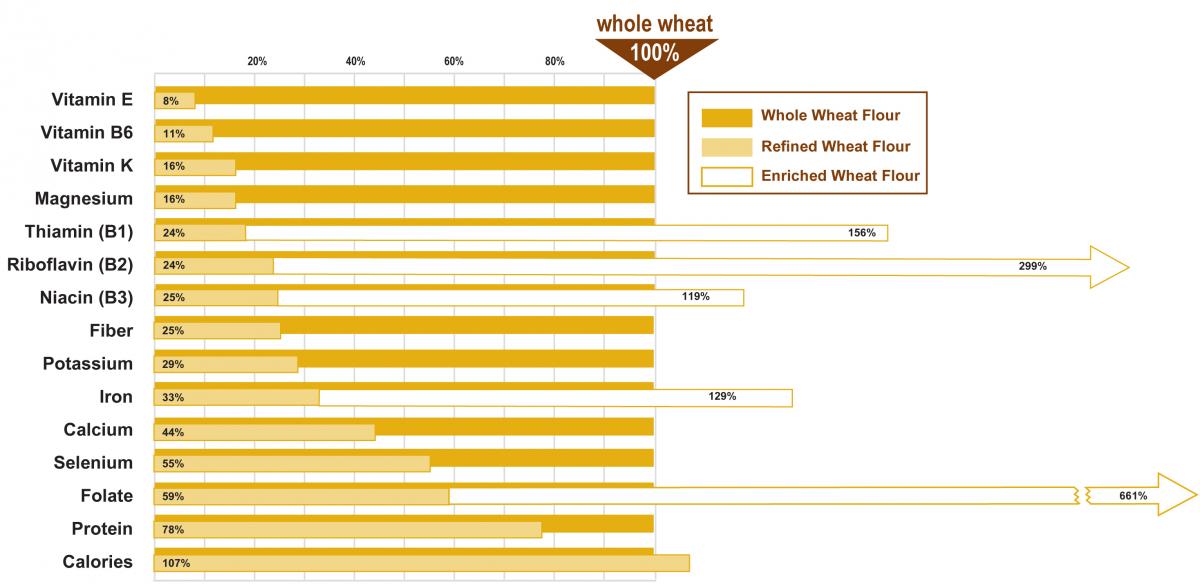Share This
Here at Oldways we firmly believe that eating well should be an enjoyable activity, not a math test. That’s why we don’t talk a lot about getting so many milligrams of this or that in every meal – and why we’d always rather talk about what foods are best to eat, rather than what nutrients. When you fill your plate with an appetizing variety of real, whole foods, the nutrients pretty much take care of themselves.
Once in a while, though, the compulsion overtakes us, and we just have to slip in a little nutrient-speak to remind everyone of why real foods – in this case, whole grains – are the way to go.
You’re probably aware in a vague sort of way that whole grains are supposed to be healthier than refined grains or enriched grains. “Sure, there’s a little bit of difference,” I can hear you saying, “but it’s no big deal.” Well, we’re here to tell you it is a big deal: refined grains are missing half to two-thirds and sometimes even more of many, many key nutrients – and enriched grains generally only add back five of those missing nutrients.
The illustration above shows the difference between whole wheat, refined wheat, and enriched wheat, for example. Growing in the field (or ground into whole wheat flour) the wheat kernel has 100% of its original nutrients, as shown by the dark gold bars. If it’s refined at the mill, its bran and germ are removed, leaving only 7% of its original Vitamin E, 17% of its original fiber, and so on, as shown by the light gold bars. “Enriching” the refined grain tosses in a large synthetic vitamin pill, adding back iron and four vitamins, none in their original amounts.
Okay, but why should we care? What do any of these 18 nutrients (or the scores of others not even listed above) matter to our bodies? We talked about protein a few weeks ago. Today, let’s look at three more to get an idea: magnesium, selenium, and fiber.
Magnesium is a mineral that your body uses in more than 300 different processes, including blood pressure regulation, blood sugar control, and muscle and nerve function. Amaranth, buckwheat, oats, quinoa, sorghum, teff and wild rice are all excellent sources of magnesium (supplying 20% or more of your daily needs), while all the other whole grains commonly eaten in our food supply – barley, cornmeal, millet, brown rice, rye, and wheat – are a good source of magnesium (supplying 10% or more of daily needs). Grab those whole grains, to reduce your risk of muscle cramps, diabetes, and high blood pressure. (See consumer and health professional fact sheets on magnesium.)
Another mineral much higher in whole grains than in refined grains is selenium, which is essential to DNA repair and to your immune system, and has antioxidant properties. A serving of wheatberries (about ¾ cup cooked) offers more than half your daily need for selenium; barley and oats are an excellent source; and amaranth, cornmeal, brown rice, rye and sorghum are all good sources of selenium. Studies show that people with the highest selenium intake have a 31% lower cancer risk, especially bladder and prostate cancer. (See consumer and health professional fact sheets on selenium.)
Dietary fiber is perhaps better known as a key advantage of whole grains over refined grains – and most people know it helps with, um, regularity. There’s more to fiber than that, however. Fiber helps you feel full faster, helping you control your weight, and it helps digestion. Getting plenty of fiber in your diet helps to feed the good bacteria in your gut, which recent research indicates may be key to supporting all-around good health. Refining grains removes around 75% of the fiber (depending on the grain) – and enriching doesn’t add any back in.
We’ll stop here, rather than run through every nutrient on the chart earlier in this blog. We’re betting that you get the idea. Whole grains offer much greater amounts of a wide array of nutrients (even beyond the 18 shown here) and they offer those nutrients in the original proportions our bodies evolved to expect.
So next time you’re at the store and you hesitate because the whole grain choice costs a few pennies more than its refined- or enriched-grain equivalent, remember that you’re getting two to three times more of many nutrients – plus a lot more flavor – for those extra pennies, making whole grains a better value all around.
(Cynthia)





Comments
Add a Comment